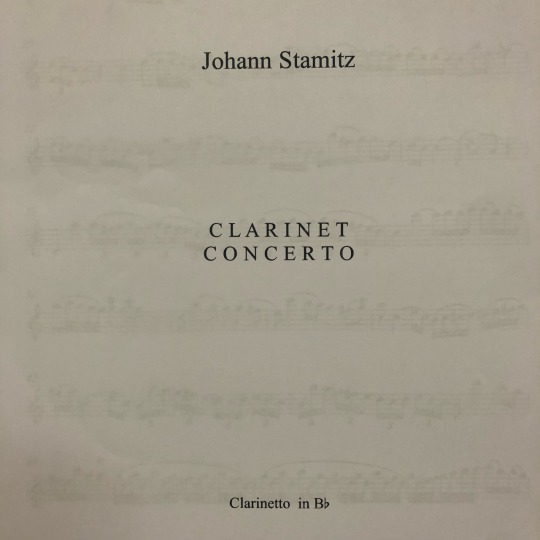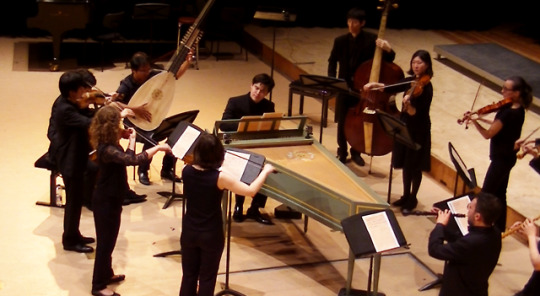#johann stamitz
Text
Johann Stamitz (1717-57) - Trio Sonata for 2 Violins and Continuo in A-Major, Op. 1 No. 2, IV. Prestissimo. Performed by Der musikalische Garten on period instruments.
#johann stamitz#classical music#rococo#classicism#violin#period performance#period instruments#trio sonata#sonata#violinist#chamber music#harpsichord#trio#rarely performed composers#strings
25 notes
·
View notes
Photo

Stamitz – Clarinet Concerto.
1976 : L'Oiseau-Lyre.
#classical music#baroque#johann stamitz#1976#concertos#clarinet#the academy of ancient music#Christopher Hogwood#l oiseau lyre#1970s#1970s classical
5 notes
·
View notes
Text
Ya’ll know the Mannheim school? Yeah. It’s real. Johann Stamitz? I played his violin concerto. :D
12 notes
·
View notes
Text
youtube
Jan Václav Stamic (Johann Stamitz) (1717-1757) - Sinfonia in A major "Frühling"
1. Allegro maestoso 2. Andante 3. Menuetto vivace 4. Commodo
Virtuosi di Praga Oldřich Vlček Conductor
3 notes
·
View notes
Text
rly abt to learn
• how to compose 18th century classical music in line with the manneheim school style of johann stamitz just to write a single original track
• learn german so i can have accurate translation errors between french and german
• literally 2 centuries of european history, politics, fashion, culture, cuisine, technology, etc
just for ethereal circumstance. why couldnt i set this in the modern day... if it gets too much i'll set in in a fictional world LOL
2 notes
·
View notes
Text
New issue Classical No.345 Johann Stamitz

0 notes
Text


Clarinet practice ^^
12 notes
·
View notes
Video
youtube
Sinfonía pastoral en re menor (Wolf D4), opus 4 n° 2, de Johann Stamitz. Versión de la Orquesta de Cámara del Norte, dirigida por el maestro Nicholas Ward.
#Johann Stamitz#Sinfonías#Sinfonía Pastoral#Re menor#Wolf D4#Opus 4#Orquesta de Cámara del Norte#Nicholas Ward
1 note
·
View note
Text
Vox Satanae - Episode #513: 15th-20th Centuries - Week of April 05, 2021
Vox Satanae – Episode #513: 15th-20th Centuries – Week of April 05, 2021
Vox Satanae – Episode #513
15th-20th Centuries
This week we hear works by Heinrich Finck, Vincenzo Galilei, Tarquinio Merula, Tomaso Vitali, Carl Stamitz, Johann Mertz, Jenő Hubay, and Valentyn Silvestrov.
148 Minutes – Week of April 05, 2021
Stream Vox Satanae Episode 513.
Download Vox Satanae Episode 513.

View On WordPress
3 notes
·
View notes
Audio
Johann Stamitz (1717-57) - Sinfonia a quattro for Strings and Basso continuo in F-Major, I. Presto. Performed by Simon Murphy/New Dutch Academy on period instruments.
#johann stamitz#classicism#classical music#orchestra#strings#period performance#period instruments#string orchestra#classical period#sinfonia#symphony#philharmonic#rococo#violin#viola#cello#double bass
24 notes
·
View notes
Text
What is a Minuet ?
A minuet is a social dance of French origin for two people, usually in 3/4 time. The word was adapted from Italian minuetto and French menuet, possibly from the French menu meaning slender, small, referring to the very small steps, or from the early 17th-century popular group dances called branle à mener or amener. The term also describes the musical form that accompanies the dance, which subsequently developed more fully, often with a longer musical form called the minuet and trio, and was much used as a movement in the early classical symphony.
Minuets were introduced—to opera at first—by Jean-Baptiste Lully, who included no fewer than 92 of them in his theatrical works and in the late 17th century the minuet was adopted into the suite, such as some of the suites of Johann Sebastian Bach and George Frideric Händel. Around Lully's time it became a common practice to score this middle section for a trio (such as two oboes and a bassoon, as is common in Lully’s music). As a result, this middle section came to be called the minuet's trio, even when no trace of such an orchestration remains. The overall structure is called rounded binary or minuet form. After these developments by Lully, composers occasionally inserted a modified repetition of the first (A) section or a section that contrasted with both the A section and what was thereby rendered the third or C section, yielding the form A–A′–B–A or A–B–C–A, respectively; an example of the latter is the third movement of Mozart's Serenade No. 13 in G major, K. 525, popularly known under the title Eine kleine Nachtmusik.
A livelier form of the minuet simultaneously developed into the scherzo (which was generally also coupled with a trio). This term came into existence approximately from Beethoven onwards, but the form itself can be traced back to Haydn. The minuet and trio eventually became the standard third movement in the four-movement classical symphony, Johann Stamitz being the first to employ it with regularity. 😌
34 notes
·
View notes
Audio
#song of the day 2018#johann stamitz#classical#this is one i heard in music history that i really liked
0 notes
Text
On June 19 in Music History
On June 19 in Music History
Be sure your student reads and listens to Today’s Daily Listening Assignment
• 1618 ~ Christian de Placker, Composer
• 1708 ~ Johann Gottlieb Janitsch, Composer
• 1717 ~ Johann Wenzel Anton Stamitz, Bohemian violist, conductor and composer
• 1730 ~ Jean-Baptiste Loeillet, Composer, died at the age of 49
• 1747 ~ Alessandro Marcello, Composer, died at the age of 77
• 1759 ~…
View On WordPress
#bandleader#composer#conductor#drummer#Gioachino Rossini#saxophonist#singer#Today in Music History#video#violist
1 note
·
View note
Text
youtube
Jan Václav Stamic (Johann Stamitz) (1717-1757) - Organ Concerto No.2 in C major
1. Moderato 2. Andante 3. Allegro
Alena Veselá, Organ
Dvořák Chamber Orchestra, Vladimir Válek Conductor
Recorded in Church of Our Lady before Týn in Prague ( pictures in video)
2 notes
·
View notes
Photo

Privates Foto der DNMO
Benefizkonzert
in der Kirche "Zu unserer lieben Frau" in Münster
am Sonntag, den 30.12.2018 um 19:30 Uhr
Ensemble des Orchesters DNMO
"Das Neue Mannheimer Orchester"
Ensemble
Anders Muskens – fortepiano, kapellmeiste Josefin Bölz – soprano Tinka Pypker – soprano
Anna Jane Triesschijn – baroque violin
Lena Rademann – baroque violin
Amandine Menuge – baroque cello
Eva Euwe – bass
Programme
Johann Stamitz – Symphonic Trio in B flat flat Op. 1 No. 5
I. Presto
II. Lento
III. Menuet
IV. Allegro
Johann Christian Bach – “Già m’abbandona la mia constanza” from Carattaco
Wolfgang Amadeus Mozart – “In uomini in soldati” from Cosi fan tutte
Anders Muskens – free fantasy keyboard improvisations
Johann Christian Bach – “Smiling Venus, goddess dear” from A Second Collection of Favourite Songs sung at Vauxhall
Mozart – “Pupille amate non lagrimate” from Lucio Silla
Johann Christian Bach – Keyboard Concerto Op. 13 No.4
I. Allegro
II. Andante
III. Andante con moto (Scottish)
2 notes
·
View notes